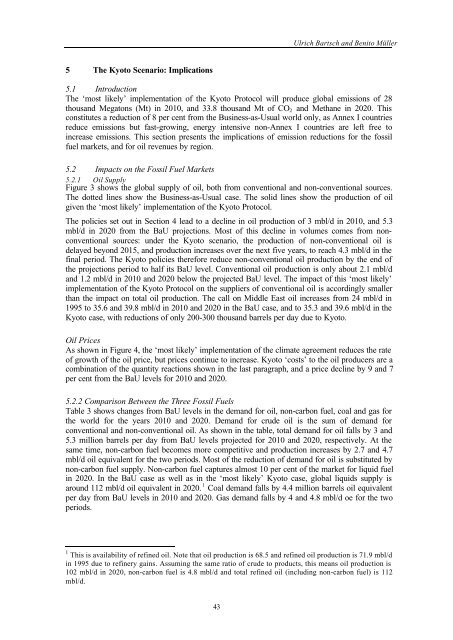sectoral economic costs and benefits of ghg mitigation - IPCC
sectoral economic costs and benefits of ghg mitigation - IPCC
sectoral economic costs and benefits of ghg mitigation - IPCC
You also want an ePaper? Increase the reach of your titles
YUMPU automatically turns print PDFs into web optimized ePapers that Google loves.
Ulrich Bartsch <strong>and</strong> Benito Müller<br />
5 The Kyoto Scenario: Implications<br />
5.1 Introduction<br />
The ‘most likely’ implementation <strong>of</strong> the Kyoto Protocol will produce global emissions <strong>of</strong> 28<br />
thous<strong>and</strong> Megatons (Mt) in 2010, <strong>and</strong> 33.8 thous<strong>and</strong> Mt <strong>of</strong> CO 2 <strong>and</strong> Methane in 2020. This<br />
constitutes a reduction <strong>of</strong> 8 per cent from the Business-as-Usual world only, as Annex I countries<br />
reduce emissions but fast-growing, energy intensive non-Annex I countries are left free to<br />
increase emissions. This section presents the implications <strong>of</strong> emission reductions for the fossil<br />
fuel markets, <strong>and</strong> for oil revenues by region.<br />
5.2 Impacts on the Fossil Fuel Markets<br />
5.2.1 Oil Supply<br />
Figure 3 shows the global supply <strong>of</strong> oil, both from conventional <strong>and</strong> non-conventional sources.<br />
The dotted lines show the Business-as-Usual case. The solid lines show the production <strong>of</strong> oil<br />
given the ‘most likely’ implementation <strong>of</strong> the Kyoto Protocol.<br />
The policies set out in Section 4 lead to a decline in oil production <strong>of</strong> 3 mbl/d in 2010, <strong>and</strong> 5.3<br />
mbl/d in 2020 from the BaU projections. Most <strong>of</strong> this decline in volumes comes from nonconventional<br />
sources: under the Kyoto scenario, the production <strong>of</strong> non-conventional oil is<br />
delayed beyond 2015, <strong>and</strong> production increases over the next five years, to reach 4.3 mbl/d in the<br />
final period. The Kyoto policies therefore reduce non-conventional oil production by the end <strong>of</strong><br />
the projections period to half its BaU level. Conventional oil production is only about 2.1 mbl/d<br />
<strong>and</strong> 1.2 mbl/d in 2010 <strong>and</strong> 2020 below the projected BaU level. The impact <strong>of</strong> this ‘most likely’<br />
implementation <strong>of</strong> the Kyoto Protocol on the suppliers <strong>of</strong> conventional oil is accordingly smaller<br />
than the impact on total oil production. The call on Middle East oil increases from 24 mbl/d in<br />
1995 to 35.6 <strong>and</strong> 39.8 mbl/d in 2010 <strong>and</strong> 2020 in the BaU case, <strong>and</strong> to 35.3 <strong>and</strong> 39.6 mbl/d in the<br />
Kyoto case, with reductions <strong>of</strong> only 200-300 thous<strong>and</strong> barrels per day due to Kyoto.<br />
Oil Prices<br />
As shown in Figure 4, the ‘most likely’ implementation <strong>of</strong> the climate agreement reduces the rate<br />
<strong>of</strong> growth <strong>of</strong> the oil price, but prices continue to increase. Kyoto ‘<strong>costs</strong>’ to the oil producers are a<br />
combination <strong>of</strong> the quantity reactions shown in the last paragraph, <strong>and</strong> a price decline by 9 <strong>and</strong> 7<br />
per cent from the BaU levels for 2010 <strong>and</strong> 2020.<br />
5.2.2 Comparison Between the Three Fossil Fuels<br />
Table 3 shows changes from BaU levels in the dem<strong>and</strong> for oil, non-carbon fuel, coal <strong>and</strong> gas for<br />
the world for the years 2010 <strong>and</strong> 2020. Dem<strong>and</strong> for crude oil is the sum <strong>of</strong> dem<strong>and</strong> for<br />
conventional <strong>and</strong> non-conventional oil. As shown in the table, total dem<strong>and</strong> for oil falls by 3 <strong>and</strong><br />
5.3 million barrels per day from BaU levels projected for 2010 <strong>and</strong> 2020, respectively. At the<br />
same time, non-carbon fuel becomes more competitive <strong>and</strong> production increases by 2.7 <strong>and</strong> 4.7<br />
mbl/d oil equivalent for the two periods. Most <strong>of</strong> the reduction <strong>of</strong> dem<strong>and</strong> for oil is substituted by<br />
non-carbon fuel supply. Non-carbon fuel captures almost 10 per cent <strong>of</strong> the market for liquid fuel<br />
in 2020. In the BaU case as well as in the ‘most likely’ Kyoto case, global liquids supply is<br />
around 112 mbl/d oil equivalent in 2020. 1 Coal dem<strong>and</strong> falls by 4.4 million barrels oil equivalent<br />
per day from BaU levels in 2010 <strong>and</strong> 2020. Gas dem<strong>and</strong> falls by 4 <strong>and</strong> 4.8 mbl/d oe for the two<br />
periods.<br />
1 This is availability <strong>of</strong> refined oil. Note that oil production is 68.5 <strong>and</strong> refined oil production is 71.9 mbl/d<br />
in 1995 due to refinery gains. Assuming the same ratio <strong>of</strong> crude to products, this means oil production is<br />
102 mbl/d in 2020, non-carbon fuel is 4.8 mbl/d <strong>and</strong> total refined oil (including non-carbon fuel) is 112<br />
mbl/d.<br />
43
















